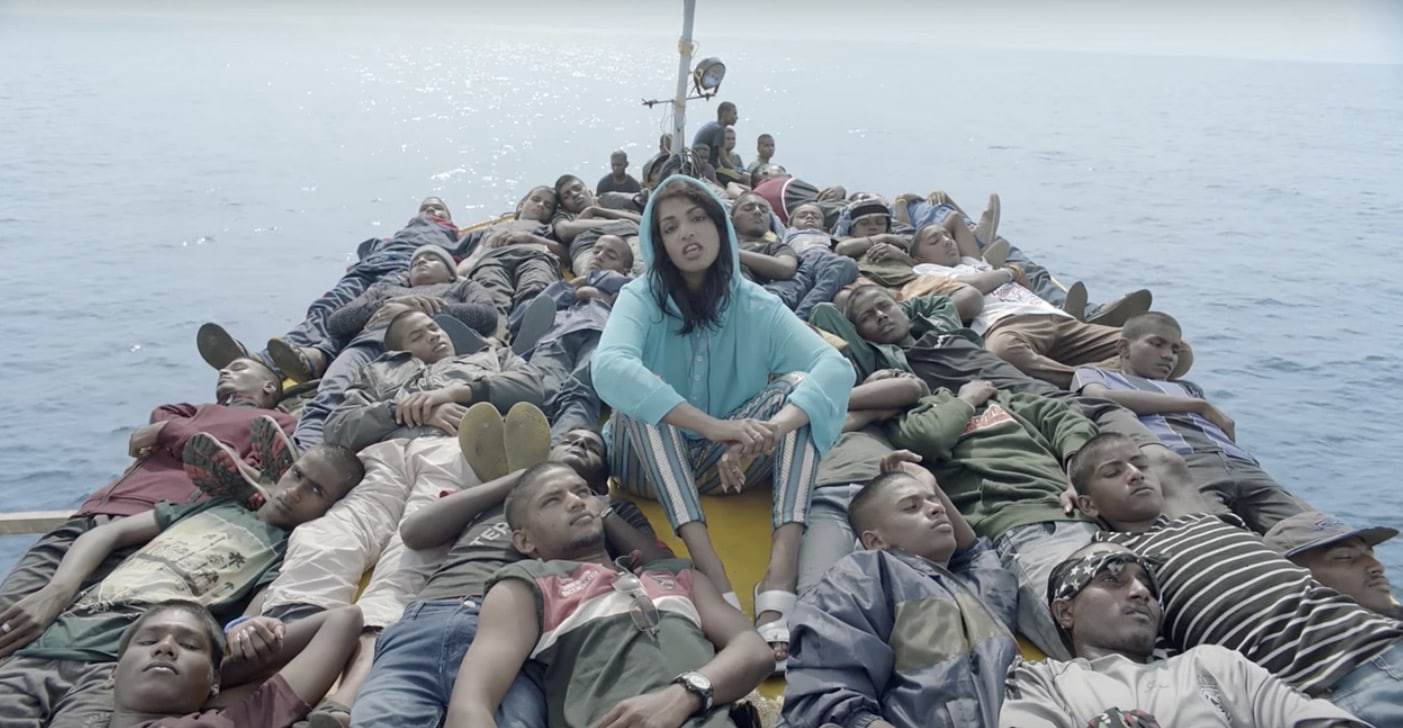 Interscope Records
Interscope Records
I take the sound of Tamil for granted when I’m with my polyglot family. Born in Sri Lanka and now living in Toronto’s eastern borough of Scarborough, I absorbed as birthright the staccato language’s combination of sarcasm and high drama — my father’s east coast drawl, and my mother’s central province shortcuts. But when navigating Toronto’s downtown core, I'd thrill to the sound of Tamil emerging from the city’s cacophony: among families on subways, between teenagers in mall food courts, and behind countertops in restaurants.
Tamil is a language that’s long been beleaguered by law and history. It’s why watching Dheepan, a French film about Sri Lankan Tamil people, in a Toronto theatre in 2016 felt like an immersion in love. The kind of slow-simmering love that can give rise to a civil war like Sri Lanka’s, and eventually establish deep roots in the Greater Toronto Area. It's a stunning film, with an ethereal soundtrack by indie electronic producer Nicolas Jaar, but it is not without its limits.
Dheepan begins in Sri Lanka. It’s May 2009, and Liberation Tigers of Tamil Eelam (LTTE) cadres are gathered around a funeral pyre, watching bodies and fatigues burn in farewell. This is the official, brutal end to a 26-year war between the Sri Lankan government and the Tigers, with Tamils in the island’s north and east bearing the brunt of the violence. After quick collages of a grief-numbed refugee camp governed by underground bureaucracies, the film's trio of protagonists — Dheepan, Illayaal, and Yalini — emerge from crowds of war survivors slumped against the tents of open-air prisons. There’s a blink-and-you’ll-miss-it view of their midnight ocean voyage off the island. And just like that, in under five minutes, the film has moved to France, and Sri Lanka is relegated to memory, represented by a recurring dream of a brooding elephant.
By fall 2015, a few months after Dheepan won the Palme D’Or at Cannes Film Festival, the film’s timeliness seemed all but fated. Dheepan had been released into a world grappling with the discovery of the waterlogged body of Syrian toddler Alan Kurdi. #RefugeesWelcome was trending globally on Twitter. British-Tamil pop star M.I.A. had released the music video for “Borders,” a hyper-stylized take on refugee narratives featuring brown men crowding fishing boats and scaling barbed wire fences.
In a recent interview with The Guardian, Dheepan director Jacques Audiard said that the film’s political project was, “persuading financiers to put €7m into a film about Tamils speaking Tamil. When I open my front door and step out into the street, I’m not seeing French cinema walk by. It’s all about representing different faces, languages, idioms, pronunciations – the lot.”
But he’s rejected efforts to consider Dheepan’s deeper political ramifications. “I don’t know what Tamils dream of,” he said in the same interview. “What interested me was this — we see migrants as people who have no faces and no names, no identity, no unconscious, no dreams. […] I wanted to give them a name, a face, a shape — and give them a violence of their own. It’s a naive film, really.”
Follow Audiard’s logic, and you’d realize that Dheepan isn’t so much a film about Tamils in France, as it is a film about immigrants-en-masse. It’s a film seeking to prove refugees are people too.
 A scene from Dheepan
IFC Films
A scene from Dheepan
IFC Films
Is that so bad? U.S. deportations reached record highs under President Barack Obama in 2012; presidential candidates Hillary Clinton and Donald Trump have hinted at policies that will bring about even worse for undocumented immigrants. In these unstable times, how harmful can a little well-intentioned generalizing be?
Recently, novelist Junot Diaz talked about how one of colonialism’s most pernicious ripple effects has been a refusal to allow racialized and Indigenous people particularity in telling the stories of their lives. It’s a base-level racism grounding the anonymizing and cornerstone terrors of slavery, the ongoing colonization of Turtle Island, and a death count in the Mediterranean of over 1,300 asylum seekers in the last five months. It’s why racialized and Indigenous people struggle to be seen, named, or heard — in life and death. And it’s also the root of the many laws and policies giving rise to heartbreaking migration stories like Dheepan’s.
Boats have long been a travel mainstay for refugees around the world. In 2009, Canada responded to the mass post-war seaborne arrivals here of Tamil refugees by fortifying laws that continue to allow for indefinite immigration detention (including of children). The first Tamil refugees to arrive in Canada were found adrift off the coast of Newfoundland in August 1986. There were 150 of them, crammed into two lifeboats. Many found their way to Toronto’s St. James Town, establishing a community that would go on to profoundly shape Canadian politics and culture. This month, Toronto’s Hot Docs Film Festival marked the 30th anniversary of their arrival with Brothers in the Kitchen, a powerful “live documentary” that highlighted the stories of some of those original travelers.
Notably, despite its name, Brothers featured women. This parallels findings that refugee women and children arriving in the EU now outnumber adult men. But with Dheepan, Audiard chose a title that centered on his male lead, despite two female protagonists (one of whom is played by a Tamil actor from India, where Tamils have not been subjected to the same kinds of state violence as in Sri Lanka). Even in the “Borders” video, M.I.A. was the only woman present, positioned against a sea of anonymized brown men, her gender the visual shock value that underscores the men’s dehumanization.
Tamil is a language that’s long been beleaguered by law and history. It’s why watching Dheepan in a Toronto theatre in 2016 felt like an immersion in love.
Dheepan is full of these kinds of real-world resonances. But Audiard’s refusal to connect the dots between the film’s art and the politics that make it topical, speak to a false dichotomy that Toni Morrison decried in her 1993 Nobel Prize speech: “Narrative is radical, creating us at the very moment it is being created.” So while conversations with Diaz, for example, are reliably for-immigrant-by-immigrant, Audiard’s good intentions are homogenizing and ultimately reduce Tamils to tropes.
There are at least 30,000 Tamils in Toronto; by other counts, there are as many as 200,000. So, here, it’s not so much that it’s easy to know what Tamils dream of, it’s that Audiard’s question is so evidently self-defeating. Here, it’s not difficult to find Tamil filmmakers, both Sri Lankan and Indian, like Sumathy Balaram and Maria-Saroja Ponnambalam, delving deeper into the complexities that Audiard skirts.
Theirs aren’t the first Canadian-Tamil films , and Dheepan isn’t the first time Tamil has graced mainstream North American screens. In Aziz Ansari’s hit Netflix series, Master of None, his real-life parents and their adorable bundle of Tamil exclamations were the best part of a melting-pot take on the young-people-who-can-somehow-afford-Manhattan genre. But, like many viewers, my joy was tempered by disappointment: for the show, Aziz, Fatima, and Shoukath had become Dev, Nisha, and Ramesh. Ansari, whose Muslim family is from the south Indian state of Tamil Nadu, had swapped north Indian Hindu names for his on-screen family. The anachronism reminds us of the limits of post-9/11 racial representation in North American cinema: Muslims can’t be anything but ambiguously Arab (thanks, Homeland), and Indians can’t be anything but Hindu.
On their own, these homogenizations might seem trifling. But taken together, they remind us not to settle for mere representation. We need to demand deeper — not just more — perspectives of and by racialized people in art. Otherwise, left to the wayside is an infinitely more interesting world.
